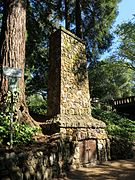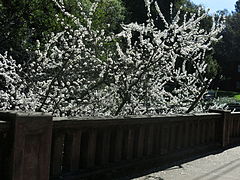Benutzer:Pimpinellus/Live Oak Park (Berkeley)
Der Live Oak Park ist eine Grünanlage inmitten der Stadt Berkeley. Er ist knapp zwei Hektar groß, in ihm und um ihn herum pulsiert das Leben einer der angesehendsten Universitätsstädte der Vereinigten Staaten. Seit über hundert Jahren ist der Life Oak Park ein Ort, an dem sich die gesellschaftliche und geistige Entwicklung Berkeley´s widerspiegelt, er ist Freizeitstätte und er bietet Raum für Basketball und Tennis. Das Live Oak Theater sowie das Berkeley Art Center sind eingerahmt von in Californien heimischen immergrünen Eichenbäumen, den Coast Live Oaks, und den das ganze Jahr über ihren intensiven Duft verströmenden Bay-Lorbeeren. Ruhige Plätze im Schatten, Sträucher, Bäume und grüne Liegeflächen wechseln sich ab, und mitten durch diesen ältesten öffentlichen Parks in Berkeley fließt ein Bach, der Codornices Creek. [1]

Geographie
[Bearbeiten | Quelltext bearbeiten]Der Life Oak Park zieht sich beidseits des Codornices Creek als schmaler Grüngürtel von Oxford Street down to Shuttack Ave hin. Die Mittelachse des Parks ist die Walnut Street. Codornices Creek meanders through its grove of native oaks, accented here and there with big, old specimen trees planted in the original gardens that preceded the park. Live Oak Park is here because of the many little creeks that flow from the Berkeley Hills the short way to San Francisco Bay. These little creeks are more powerful than they look. As rising sea level filled the current Bay at the end of the last Ice Age, the creeks basically built what are now the flatlands, by carrying rock and soil eroded from the earthquake-riven, still-rising hills. Der den Live Oak Park prägende Codornices Creek (sometimes spelled and/or pronounced "Cordonices) ist einer dieser ursprünglichen creeks which runs out of the Berkeley Hills in the San Francisco Bay Area in California. In its upper stretch, it passes entirely within the city limits von Berkeley and marks the city limit with the adjacent city of Albany in its lower section. Der Name des Greeks derives from the Spanish word "codornices", meaning "quails". California valley quail were once common in the area. The name was given by one of the Peraltas, owners of the vast Rancho San Antonio.
Geschichte
[Bearbeiten | Quelltext bearbeiten]Ursprung
[Bearbeiten | Quelltext bearbeiten]In the early days of Berkeley, the vast area that now includes the Life Oak Park and its neighborhoods and which extended over the top of the Berkeley Hills, was acquired in 1860 by one of Berkeley’s earliest settlers, Napoleon Bonaparte Byrne. He and his family and Pete and Hannah Byrne, two former slaves who had been freed prior to the journey west, made the long trek across the continent from Missouri to settle on the banks of Codornices Creek and to begin farming their 800 acres. Because the Byrnes had invested in a farming venture in the Delta, they began selling their Berkeley property piece by piece, beginning in 1873.
-
Codornices Creek
-
Picnic Area, Stone Fireplace
-
Pittosporum undulatum Klebsamen
-
Japanische Kirsche an der Brücke
Park und Kulturzentrum
[Bearbeiten | Quelltext bearbeiten]Henry Berryman purchased the Byrne House with ten adjoining acres and it became known as the Berryman place. Envisioning a developing town, Henry Berryman, as owner of the Berkeley Waterworks, built the Berryman Reservoir (still located a few blocks above the Live Oak Park), and also extended the steam train line north on Shattuck to Vine Street (Berryman Station), both as measures to increase the desirability of his North Berkeley lots. A few of the earliest houses built then are still standing today. When the extensive Byrne lands were subdivided by Henry Berryman in the 1870s, two parcels on Codornices Creek remained intact and were developed as private estate. To the north of the creek was the home of Michael O´Toole and Russell Penniman owned the property to the south. On March 10, 1914 the City Council approved an ordinance appropriating $ 72.500 to purchase the property to establish a city park. At that time Berkeley, like many other American cities, was swept up in the City Beautiful Movement, and had recently commissioned a report on city planning, which revealed a lack of public parks. The city took formal possession of the property on Juli 1 and the unnamed park was opened to the public with appropriate ceremony. For the next two weeks everyone ´s mind was on choosing a name for the new park and suggestions were published almost daily in the Berkeley Gazette. ( Quelle: Berkeley Gazette, Among those names proposed were “Penniman”, “Berryman”, and even “Whitehall” (the name of Bishop Berkeley´s home). On July 14, 19145, the City Counsil adopted “Live Oak”. Several years later the park was extended one block to Oxford Street, Codornices Creek and its groves of both native and introduced trees were preserved. One of the first improvements was the present Walnut Street Bridge, designed in 1915. In 1917 a large, stone Arts & Crafts fireplace was built, an in 1918 William Miles donates a rustic aviary. Penniman’s brown shingle became the clubhouse and North Branch library. When the Penniman Clubhouse burned in 1951 the city built the current Live Oak Community Center, das "Live Oak Park Recreation Center, Social Hall Shattuck & Berryman, Berkeley, California"[2], wo unter anderen die "Berkeley Folk Dancers" beheimatet sind. Auf der anderen Seite der Walnut-Street-Brücke entstand das Berkeley Art Center.



